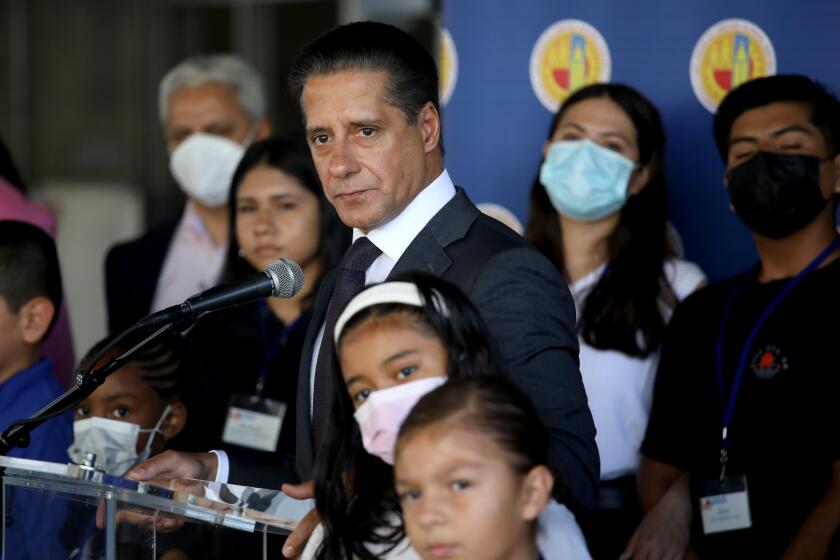L.A. Unified enrollment continues to fall, but drop is cushioned by influx of 4-year-olds

Student enrollment at Los Angeles Unified continued to decline this fall â although less than district officials had predicted â as new state funding expanded transitional kindergarten to more 4-year-olds.
At Tuesdayâs school board meeting, Supt. Alberto Carvalho said the enrollment of 422,276 â spanning from transitional kindergarten through 12 grade â is a âreason for celebration.â He pointed toward the predicted decline of 4.1% versus the actual decline of 1.9%, the smallest drop since 2013-14.
âBut the work continues,â Carvalho said.
The âstabilization of enrollment in the aftermath of the pandemic,â Carvalho said, âis a phenomenon that is interesting, that Iâve seen only in one additional large urban district in our country. And thatâs actually Miami-Dade,â he said, referring to the school system where he served as superintendent before coming to L.A. in February.
The enrollment numbers were helped by a substantial expansion of transitional kindergarten spots because of an increase in state funding that is essentially creating a new grade over the next few years.
The number of students in transitional kindergarten increased by about 2,700 to more than 8,400, a 47% rise. Without that increase, L.A. Unifiedâs overall enrollment would have slipped by 2.5%
Carvalho suggested that higher-than-expected numbers of students were drawn to L.A. Unified because of its reputation for strong health-safety protocols â earned during the pandemic. And other families, he said, were probably attracted by the relaxing of some of these protocols. The district ended weekly COVID testing this summer and made masking optional last spring.
Officials conceded, however, they are speculating. Factors contributing to lower enrollment are complex and include birth rates, decreased immigration, high living costs that compel families to move and competition from independently operated charter schools. More than 200 charters operate within L.A. Unified; many of them also are having problems filling seats. Also, an unknown number of students simply stopped attending classes during the pandemic campus closures.
Officials are also scrambling to fill 800 teacher positions and hire 200 bus drivers, with school set to resume in two weeks.
Board member Jackie Goldberg spoke of a need for a marketing campaign.
âIâve seen schools in my board district that have things that nobody knows about,â she said. âI went to a school where theyâre making hydrogen motors and drank from the tailpipeâ â alluding to water being the waste produce of a hydrogen motor. She was referencing the prize-winning student mechanic-scientists at STEAM Legacy High School in South Gate, who have competed internationally.
âI just think that there are parents everywhere who would love to have their kids in a school thatâs creating hydrogen motors.â
Enrollment has been incrementally dropping in L.A. Unified since peaking at about 737,000 students 21 years ago. That long-ago overcrowding detracted from the quality and even quantity of education â as campuses operated year-round with students on staggered schedules that provided 17 fewer days of instruction per year and limited access to advanced classes.
The challenge will now be to keep campuses open and programs viable as enrollment shrinks.
While acknowledging the better-than-expected numbers, board member Nick Melvoin asked Carvalho to explain why the combined increase in transitional kindergarten and preschool is only about 3,000 students when the district announced this fall that about 19,000 new early education seats were available.
The actual numbers are âfar short of the 19,000 youâre talking about,â Melvoin said. âWhy such a huge discrepancy?â
âThe expansion was a multiyear goal,â Carvalho responded. âSo we are progressing towards that goal, not necessarily slower than anticipated.â
Melvoin said that the variety of programs for students ages 4 and younger â with different formats and eligibility rules â could be confusing to parents without improved district outreach.
Large urban districts, including L.A. Unified, accounted for about one-third of the decline.
At this rate, universal enrollment of 4-year-olds would be âa decade away,â said UC Berkeley education professor Bruce Fuller, who did not blame Carvalho for the disappointing pace, which, he said, is also evident elsewhere. Transitional kindergarten and kindergarten are not mandatory in California.
âIndependent of forecasts,â he added, the enrollment decline has resumed its typical pre-pandemic pattern.
âWhether parents are feeling more comfortable or Mr. Carvalhoâs efforts have proved potent, we have moved past the COVID-era collapse of school attendance,â Fuller said.
The data bear this out.
Before the pandemic, in the fall of 2019, kindergarten enrollment statewide was 523,009. By fall 2020, when most California public schools were online, kindergarten enrollment dropped 11.6% to 462,172. The decrease was even greater, 14%, in Los Angeles Unified.
When in-person classes resumed for most in fall 2021, kindergarten numbers across California rose 1.7%, a greater rebound than for any other grade. At L.A. Unified, however, kindergarten enrollment fell further, by an additional 6%, officials said.
This year the drop in kindergarten in L.A. Unified is 1.2%.
During Tuesdayâs meeting, when board members asked detailed questions, district staff pleaded for patience.
They could not explain why in 12th grade thereâs been a 1.6% decrease after a prediction of a 2.6% increase.
Nor did they know if extending more elementary schools to eighth grade would keep more students in the district. They could not say if magnet schools â which have special programs and no attendance boundaries â bring in new students or draw instead from other district schools.
âIf youâre going to have a successful marketing strategy, we have to know the answers to those questions,â said Chief Financial Officer David Hart, who led the staff presentation. âIt will not be a one-size-fits-all across the board.â
The district has prepared a report with school-by-school enrollment but not yet a breakdown by race or geography.
âWhat we are very intent on is understanding what is within our control,â Hart said, and how to âleverage our skills, our talents, our finances, for that matter, to ensure that we are a district of choice.â
More to Read
Sign up for Essential California
The most important California stories and recommendations in your inbox every morning.
You may occasionally receive promotional content from the Los Angeles Times.













